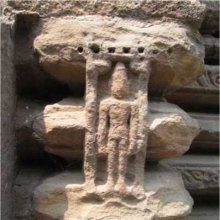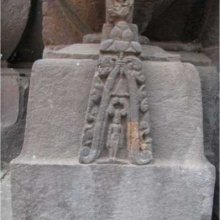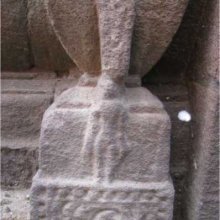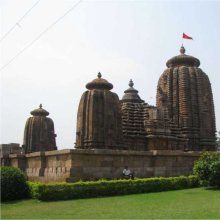Brahmeshvara, Brahmeśvara, Brahma-ishvara: 6 definitions
Introduction:
Brahmeshvara means something in Hinduism, Sanskrit. If you want to know the exact meaning, history, etymology or English translation of this term then check out the descriptions on this page. Add your comment or reference to a book if you want to contribute to this summary article.
The Sanskrit term Brahmeśvara can be transliterated into English as Brahmesvara or Brahmeshvara, using the IAST transliteration scheme (?).
Images (photo gallery)
In Hinduism
Shaivism (Shaiva philosophy)
Source: Wisdom Library: ŚaivismBrahmeśvara (ब्रह्मेश्वर) is the name of a Liṅga (symbolical manifestation of Śiva) that is associated with the Brahmagaṅgā-tīrtha (a sacred bathing place). It represents the twenty-seventh of the sixty-four siddhaliṅgas mentioned in the Nepalese Tyasaphu (a folding book or leporello). At each of these spots Śiva is manifest as a Liṅga. Each of these liṅgas (e.g., Brahma-īśvara) has its own specific name, mantra, set of rituals and observances, auspicious time etc.
The auspiscious time for bathing near the Brahmeśvara-liṅga at the Brahmagaṅgā-tīrtha is mentioned as “māgha-pūrṇimā phālguṇa-kṛṣṇa aṣṭamī” (latin: magha-purnima phalguna-krishna ashtami). This basically represents the recommended day for bathing there (snānadina).

Shaiva (शैव, śaiva) or Shaivism (śaivism) represents a tradition of Hinduism worshiping Shiva as the supreme being. Closely related to Shaktism, Shaiva literature includes a range of scriptures, including Tantras, while the root of this tradition may be traced back to the ancient Vedas.
Shilpashastra (iconography)
Source: Shodhganga: The significance of the mūla-beras (śilpa)Brahmeśvara refers to one of the sixteen liṅgas worshipped in the maṇḍapas at the Adi Kumbeswarar Temple (Ādi Kumbheśvara) in Kumbakonam (Kumbhakonam), representing a sacred place for the worship of Śiva.—The Ādi Kumbheśvar Temple has three towers. The first Rājagopura is 128 feet high with 9 tiers. The tower is noted for the beauty of the sculptures carved on it. The mūlavar is Kumbheśa Āvudayar in the form of a liṅga. The figure of Lord Murukan in the temple is unique. He is seen with six faces and six hands. The big mahāmaha tank lends a unique glory to this sthala. It is called Amuda Saroruhamand Kaniyūr Tīrta. There are sixteen maṇḍapas around the temple. The sixteen liṅgas worshipped in the maṇḍapas are, [for example, Brahmeśvara]. They are said to have been built in 1542 by Govinda Dikṣitar who was a Minister of Achyutappa Nayakar, the king of Tanjore.

Shilpashastra (शिल्पशास्त्र, śilpaśāstra) represents the ancient Indian science (shastra) of creative arts (shilpa) such as sculpture, iconography and painting. Closely related to Vastushastra (architecture), they often share the same literature.
Purana and Itihasa (epic history)
Source: Shodhganga: The saurapurana - a critical studyBrahmeśvara (ब्रह्मेश्वर) is the name of a Tīrtha (holy places) situated at Vārāṇasī, according to the 10th century Saurapurāṇa: one of the various Upapurāṇas depicting Śaivism.—Vārāṇasī has remained a place dear to Śiva. It is supposed to be a place of mokṣa for all living creatures. There are many sacred places and innumerable liṅgas which are even unknown to Brahmā, so says the Saurapurāṇa. [...] There is also the holy place Brahmeśvara where Virāṭa-brahman performed great penance to please diva and by propiating Brahmeśvara-Śiva, Brahman received his Brahman-hood. A visit to this tīrtha gives the result of all sacrifices.

The Purana (पुराण, purāṇas) refers to Sanskrit literature preserving ancient India’s vast cultural history, including historical legends, religious ceremonies, various arts and sciences. The eighteen mahapuranas total over 400,000 shlokas (metrical couplets) and date to at least several centuries BCE.
Languages of India and abroad
Sanskrit dictionary
Source: Cologne Digital Sanskrit Dictionaries: Edgerton Buddhist Hybrid Sanskrit DictionaryBrahmeśvara (ब्रह्मेश्वर).—name of two former Buddhas: Samādhirājasūtra p. 57 lines 7, 8, 9 (compare Brahmasvara).
Source: Cologne Digital Sanskrit Dictionaries: Aufrecht Catalogus CatalogorumBrahmeśvara (ब्रह्मेश्वर) as mentioned in Aufrecht’s Catalogus Catalogorum:—Gaṇapatiratnapradīpa.
Source: Cologne Digital Sanskrit Dictionaries: Monier-Williams Sanskrit-English DictionaryBrahmeśvara (ब्रह्मेश्वर):—[from brahma > brahman] m. Name of an author, [Catalogue(s)]
Sanskrit, also spelled संस्कृतम् (saṃskṛtam), is an ancient language of India commonly seen as the grandmother of the Indo-European language family (even English!). Closely allied with Prakrit and Pali, Sanskrit is more exhaustive in both grammar and terms and has the most extensive collection of literature in the world, greatly surpassing its sister-languages Greek and Latin.
See also (Relevant definitions)
Partial matches: Ishvara, Brahma.
Starts with: Brahmeshvaratirtha.
Full-text: Brahmeshvaratirtha, Ganapatiratnapradipa, Brahmasvara, Brahmagangatirtha, Grihandapatika, Ravvapallika, Linga, Brahmakundi, Simhatunda, Adi Kumbeswarar.
Relevant text
Search found 16 books and stories containing Brahmeshvara, Brahmeśvara, Brahma-ishvara, Brahma-īśvara, Brahmesvara, Brahma-isvara; (plurals include: Brahmeshvaras, Brahmeśvaras, ishvaras, īśvaras, Brahmesvaras, isvaras). You can also click to the full overview containing English textual excerpts. Below are direct links for the most relevant articles:
The Skanda Purana (by G. V. Tagare)
Chapter 318 - Greatness of Brahmeśvara (Brahma-īśvara) < [Section 1 - Prabhāsa-kṣetra-māhātmya]
Chapter 245 - Greatness of Brahmeśvara (Brahma-īśvara) < [Section 1 - Prabhāsa-kṣetra-māhātmya]
Chapter 150 - Greatness of Brahmeśvara (Brahma-īśvara) < [Section 1 - Prabhāsa-kṣetra-māhātmya]
Jainism in Odisha (Orissa) (by Ashis Ranjan Sahoo)
Tirthankara image, Barabati Fort < [Chapter 3: Survey of Jaina Antiquities in Odisha]
Jaina Antiquities at Bhubaneswar (Khordha) < [Chapter 3: Survey of Jaina Antiquities in Odisha]
Lakulisha-Pashupata (Philosophy and Practice) (by Geetika Kaw Kher)
Kalamukhas and Virasaivas: The present day tradition < [Chapter 2 - Spread and Transition]
Srikantha in the Saiva pantheon < [Chapter 1 - The Historical Context]
Historicity (of the term linga) < [Chapter 6 - Siva-linga: an Iconological Study]
Middle Chola Temples (by S. R. Balasubrahmanyam)
Temples in Brahmadesam (South Arcot) < [Chapter II - Temples of Rajaraja I’s Time]
Chaitanya Bhagavata (by Bhumipati Dāsa)
Verse 3.2.401 < [Chapter 2 - Description of the Lord’s Travel Through Bhuvaneśvara and Other Placesto Jagannātha Purī]
The Shiva Purana (by J. L. Shastri)
Chapter 2 - The greatness of Śivaliṅgas < [Section 4 - Koṭirudra-Saṃhitā]




